VIT MITS5505 Knowledge Management Case Study: Exercises 4, 5, and 7
VerifiedAdded on 2022/10/17
|12
|1796
|13
Homework Assignment
AI Summary
This assignment solution addresses a Knowledge Management case study (MITS5505) involving exercises on brainstorming, nominal group technique, consensus decision making, and knowledge codification. The solution analyzes how Australian organizations can enhance employee perception of personal worth through brainstorming techniques, the nominal group technique, and consensus decision-making. It also explores knowledge codification using frames for a horse, a student, and an airline pilot. Furthermore, the document discusses the selection of knowledge developers and provides insights into the failure of knowledge management implementation in a global company, examining five key stages: advocate and learn, strategy development, KM initiatives, support and expand initiatives, and institutionalize knowledge management. The provided solution offers a comprehensive understanding of the key concepts and practical applications within the realm of knowledge management, as required in the assignment.
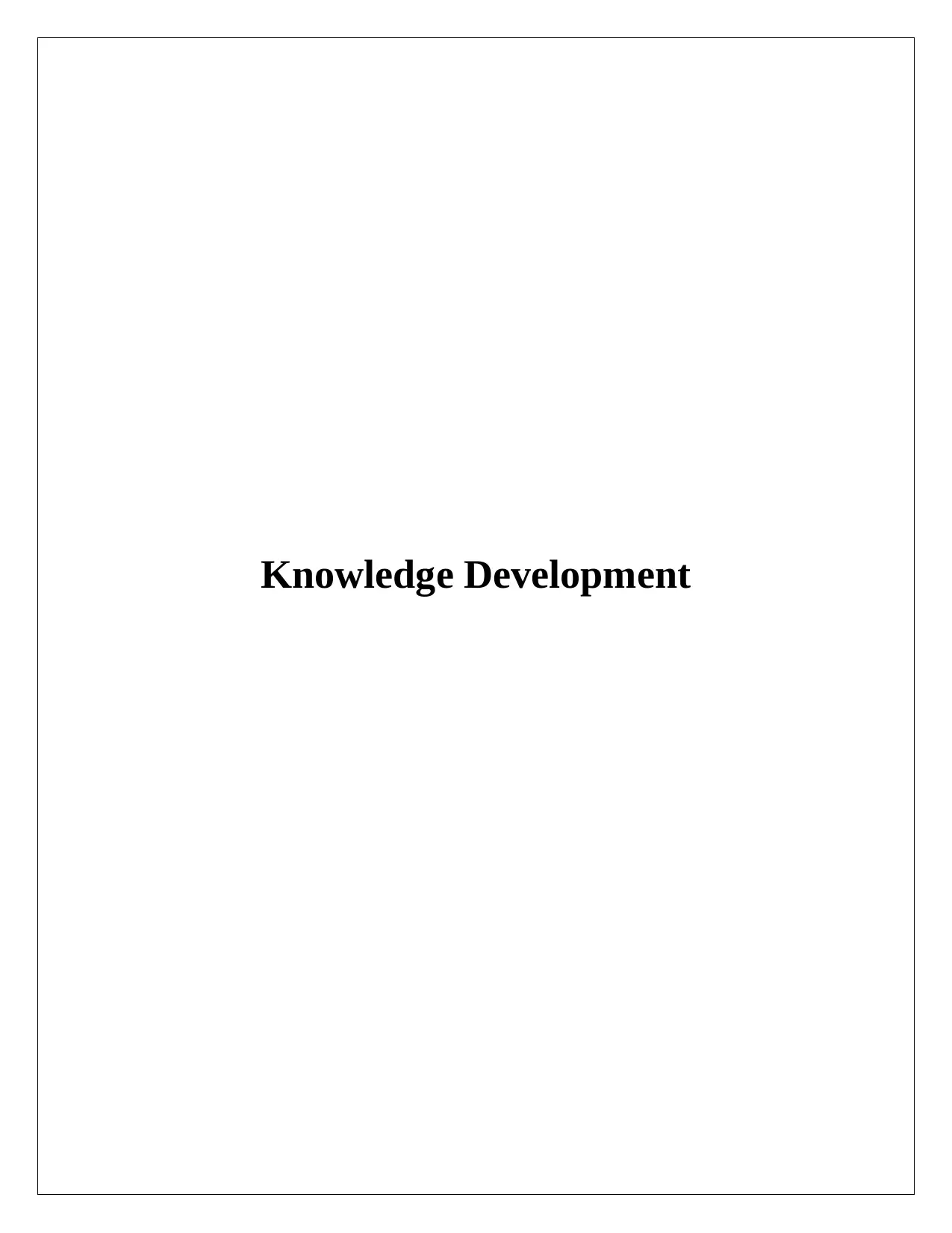
Knowledge Development
Paraphrase This Document
Need a fresh take? Get an instant paraphrase of this document with our AI Paraphraser
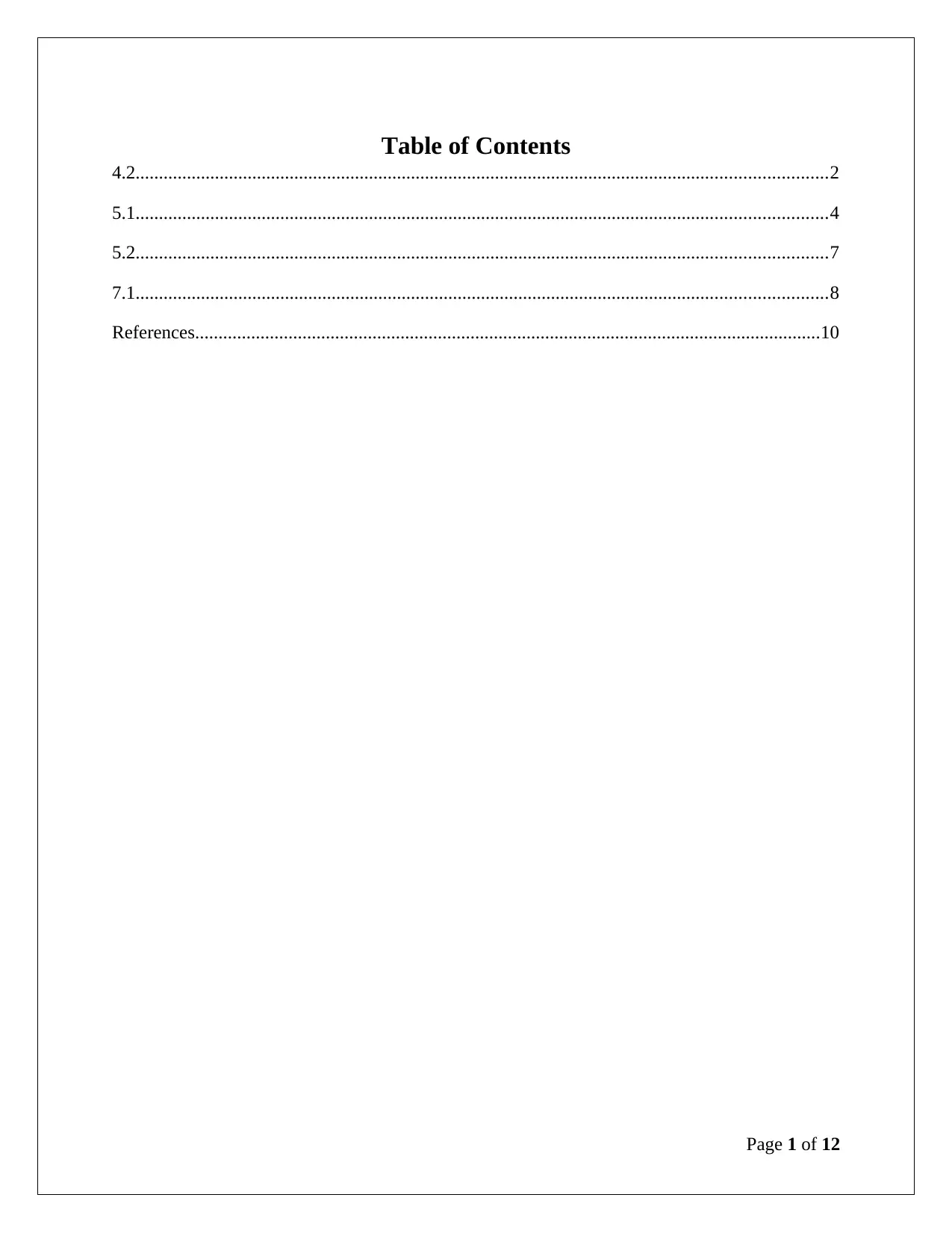
Table of Contents
4.2....................................................................................................................................................2
5.1....................................................................................................................................................4
5.2....................................................................................................................................................7
7.1....................................................................................................................................................8
References......................................................................................................................................10
Page 1 of 12
4.2....................................................................................................................................................2
5.1....................................................................................................................................................4
5.2....................................................................................................................................................7
7.1....................................................................................................................................................8
References......................................................................................................................................10
Page 1 of 12
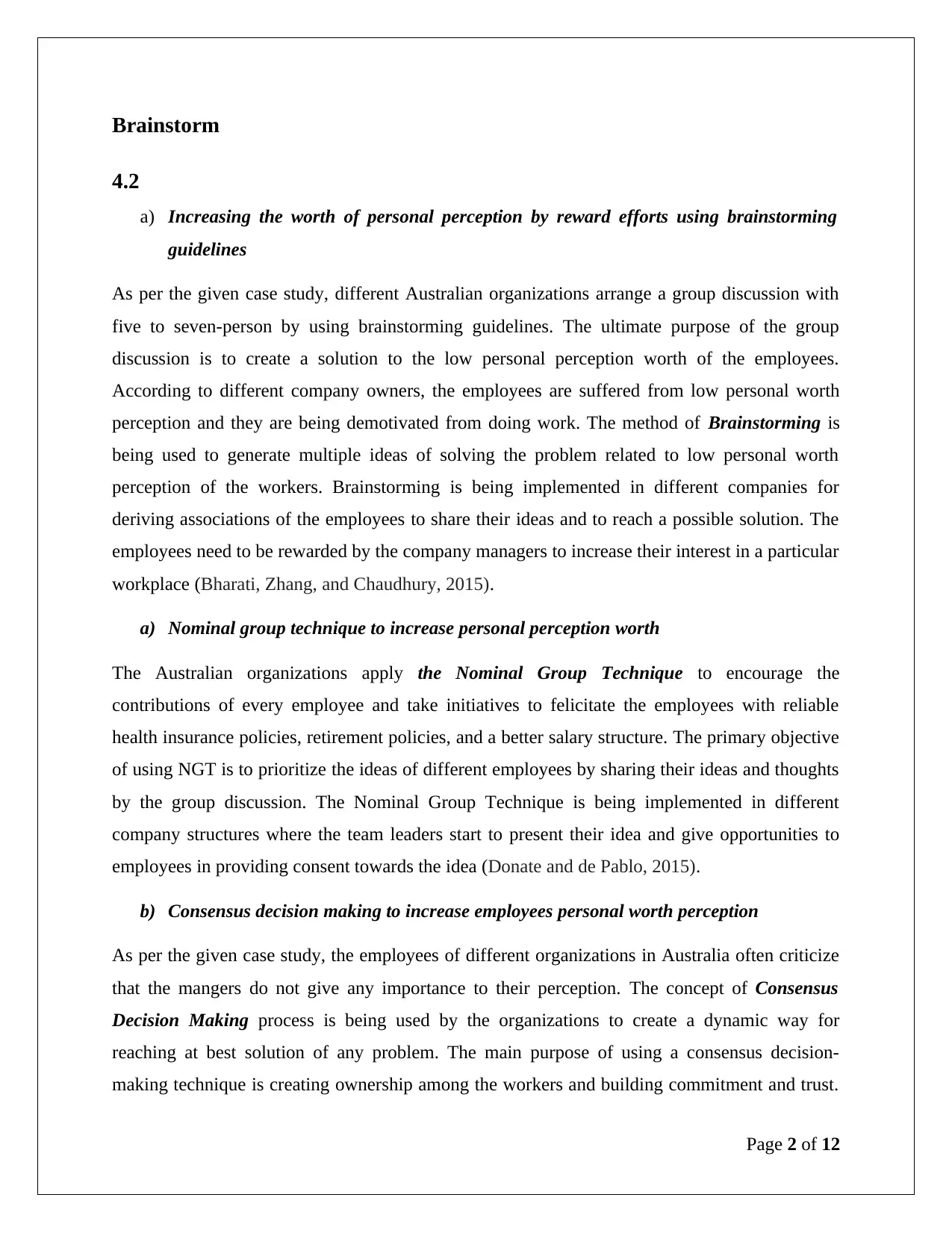
Brainstorm
4.2
a) Increasing the worth of personal perception by reward efforts using brainstorming
guidelines
As per the given case study, different Australian organizations arrange a group discussion with
five to seven-person by using brainstorming guidelines. The ultimate purpose of the group
discussion is to create a solution to the low personal perception worth of the employees.
According to different company owners, the employees are suffered from low personal worth
perception and they are being demotivated from doing work. The method of Brainstorming is
being used to generate multiple ideas of solving the problem related to low personal worth
perception of the workers. Brainstorming is being implemented in different companies for
deriving associations of the employees to share their ideas and to reach a possible solution. The
employees need to be rewarded by the company managers to increase their interest in a particular
workplace (Bharati, Zhang, and Chaudhury, 2015).
a) Nominal group technique to increase personal perception worth
The Australian organizations apply the Nominal Group Technique to encourage the
contributions of every employee and take initiatives to felicitate the employees with reliable
health insurance policies, retirement policies, and a better salary structure. The primary objective
of using NGT is to prioritize the ideas of different employees by sharing their ideas and thoughts
by the group discussion. The Nominal Group Technique is being implemented in different
company structures where the team leaders start to present their idea and give opportunities to
employees in providing consent towards the idea (Donate and de Pablo, 2015).
b) Consensus decision making to increase employees personal worth perception
As per the given case study, the employees of different organizations in Australia often criticize
that the mangers do not give any importance to their perception. The concept of Consensus
Decision Making process is being used by the organizations to create a dynamic way for
reaching at best solution of any problem. The main purpose of using a consensus decision-
making technique is creating ownership among the workers and building commitment and trust.
Page 2 of 12
4.2
a) Increasing the worth of personal perception by reward efforts using brainstorming
guidelines
As per the given case study, different Australian organizations arrange a group discussion with
five to seven-person by using brainstorming guidelines. The ultimate purpose of the group
discussion is to create a solution to the low personal perception worth of the employees.
According to different company owners, the employees are suffered from low personal worth
perception and they are being demotivated from doing work. The method of Brainstorming is
being used to generate multiple ideas of solving the problem related to low personal worth
perception of the workers. Brainstorming is being implemented in different companies for
deriving associations of the employees to share their ideas and to reach a possible solution. The
employees need to be rewarded by the company managers to increase their interest in a particular
workplace (Bharati, Zhang, and Chaudhury, 2015).
a) Nominal group technique to increase personal perception worth
The Australian organizations apply the Nominal Group Technique to encourage the
contributions of every employee and take initiatives to felicitate the employees with reliable
health insurance policies, retirement policies, and a better salary structure. The primary objective
of using NGT is to prioritize the ideas of different employees by sharing their ideas and thoughts
by the group discussion. The Nominal Group Technique is being implemented in different
company structures where the team leaders start to present their idea and give opportunities to
employees in providing consent towards the idea (Donate and de Pablo, 2015).
b) Consensus decision making to increase employees personal worth perception
As per the given case study, the employees of different organizations in Australia often criticize
that the mangers do not give any importance to their perception. The concept of Consensus
Decision Making process is being used by the organizations to create a dynamic way for
reaching at best solution of any problem. The main purpose of using a consensus decision-
making technique is creating ownership among the workers and building commitment and trust.
Page 2 of 12
⊘ This is a preview!⊘
Do you want full access?
Subscribe today to unlock all pages.

Trusted by 1+ million students worldwide
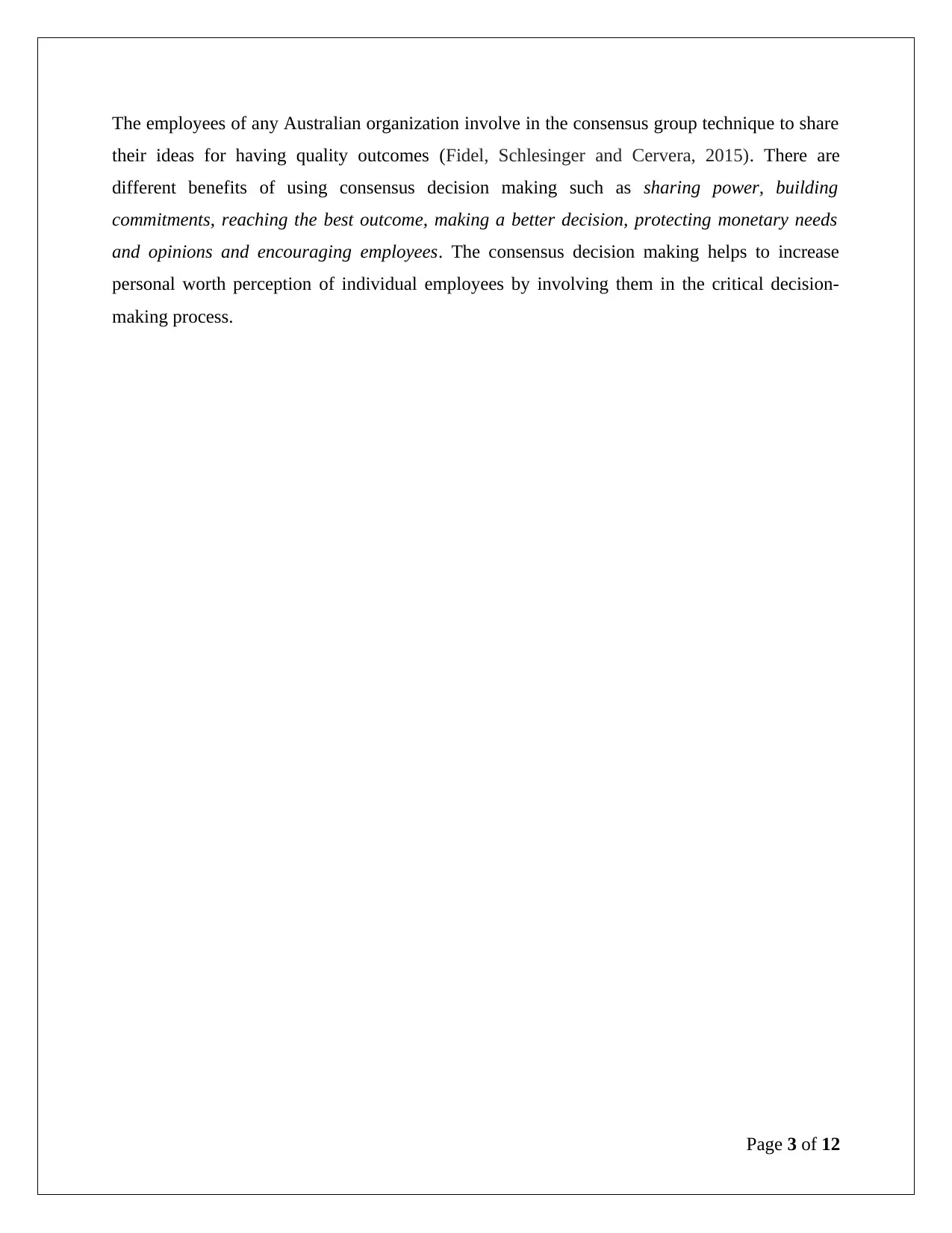
The employees of any Australian organization involve in the consensus group technique to share
their ideas for having quality outcomes (Fidel, Schlesinger and Cervera, 2015). There are
different benefits of using consensus decision making such as sharing power, building
commitments, reaching the best outcome, making a better decision, protecting monetary needs
and opinions and encouraging employees. The consensus decision making helps to increase
personal worth perception of individual employees by involving them in the critical decision-
making process.
Page 3 of 12
their ideas for having quality outcomes (Fidel, Schlesinger and Cervera, 2015). There are
different benefits of using consensus decision making such as sharing power, building
commitments, reaching the best outcome, making a better decision, protecting monetary needs
and opinions and encouraging employees. The consensus decision making helps to increase
personal worth perception of individual employees by involving them in the critical decision-
making process.
Page 3 of 12
Paraphrase This Document
Need a fresh take? Get an instant paraphrase of this document with our AI Paraphraser
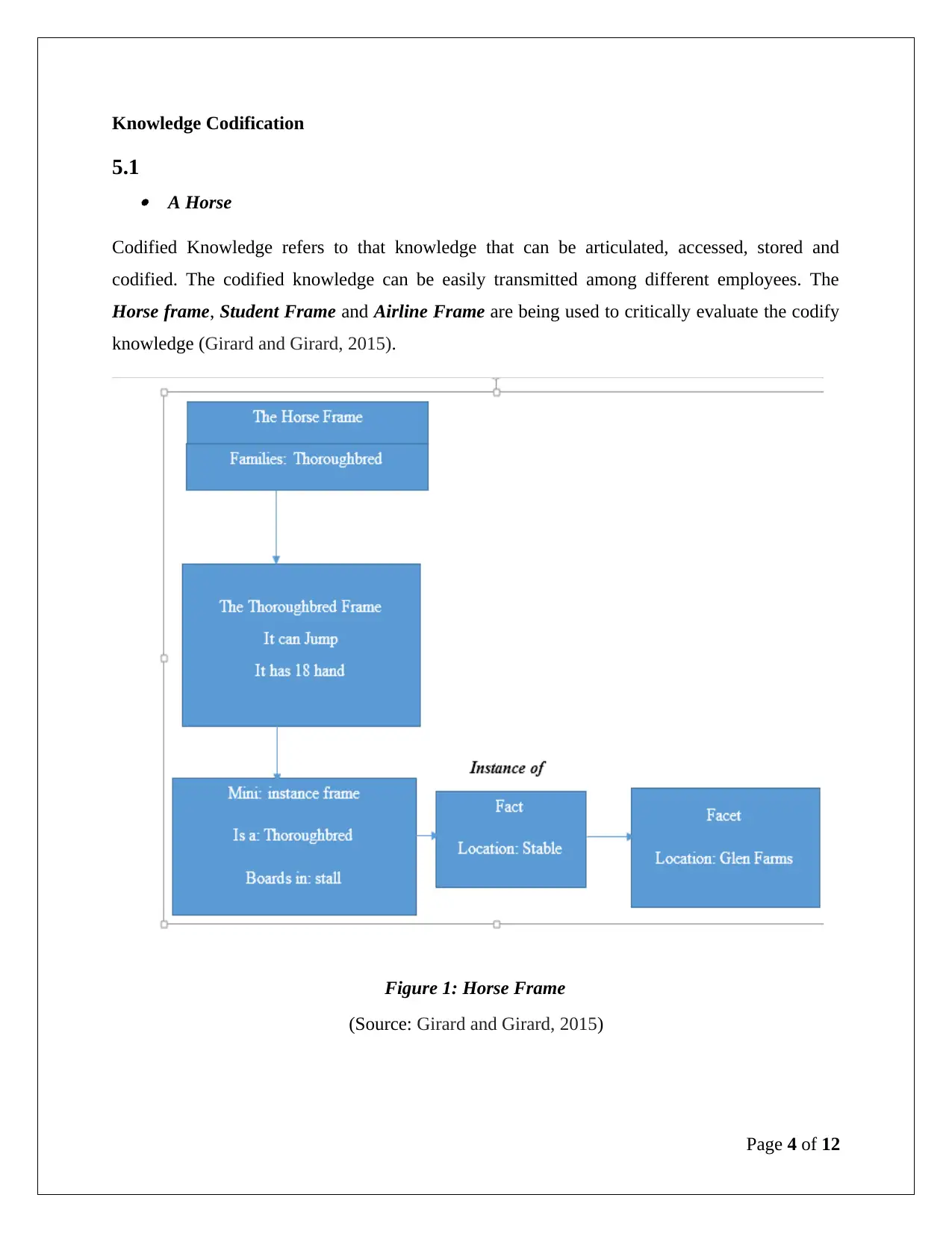
Knowledge Codification
5.1 A Horse
Codified Knowledge refers to that knowledge that can be articulated, accessed, stored and
codified. The codified knowledge can be easily transmitted among different employees. The
Horse frame, Student Frame and Airline Frame are being used to critically evaluate the codify
knowledge (Girard and Girard, 2015).
Figure 1: Horse Frame
(Source: Girard and Girard, 2015)
Page 4 of 12
5.1 A Horse
Codified Knowledge refers to that knowledge that can be articulated, accessed, stored and
codified. The codified knowledge can be easily transmitted among different employees. The
Horse frame, Student Frame and Airline Frame are being used to critically evaluate the codify
knowledge (Girard and Girard, 2015).
Figure 1: Horse Frame
(Source: Girard and Girard, 2015)
Page 4 of 12
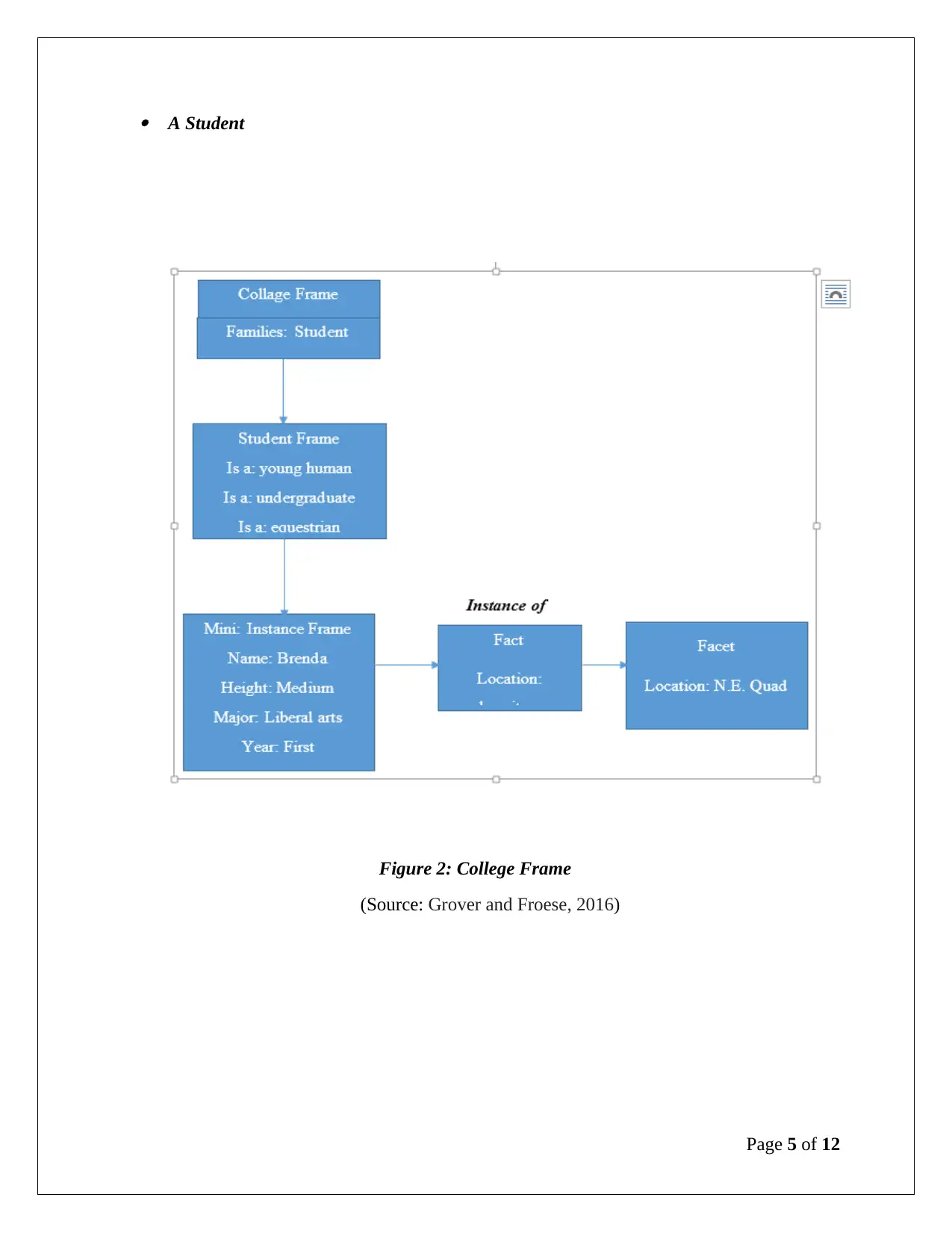
A Student
Figure 2: College Frame
(Source: Grover and Froese, 2016)
Page 5 of 12
Figure 2: College Frame
(Source: Grover and Froese, 2016)
Page 5 of 12
⊘ This is a preview!⊘
Do you want full access?
Subscribe today to unlock all pages.

Trusted by 1+ million students worldwide
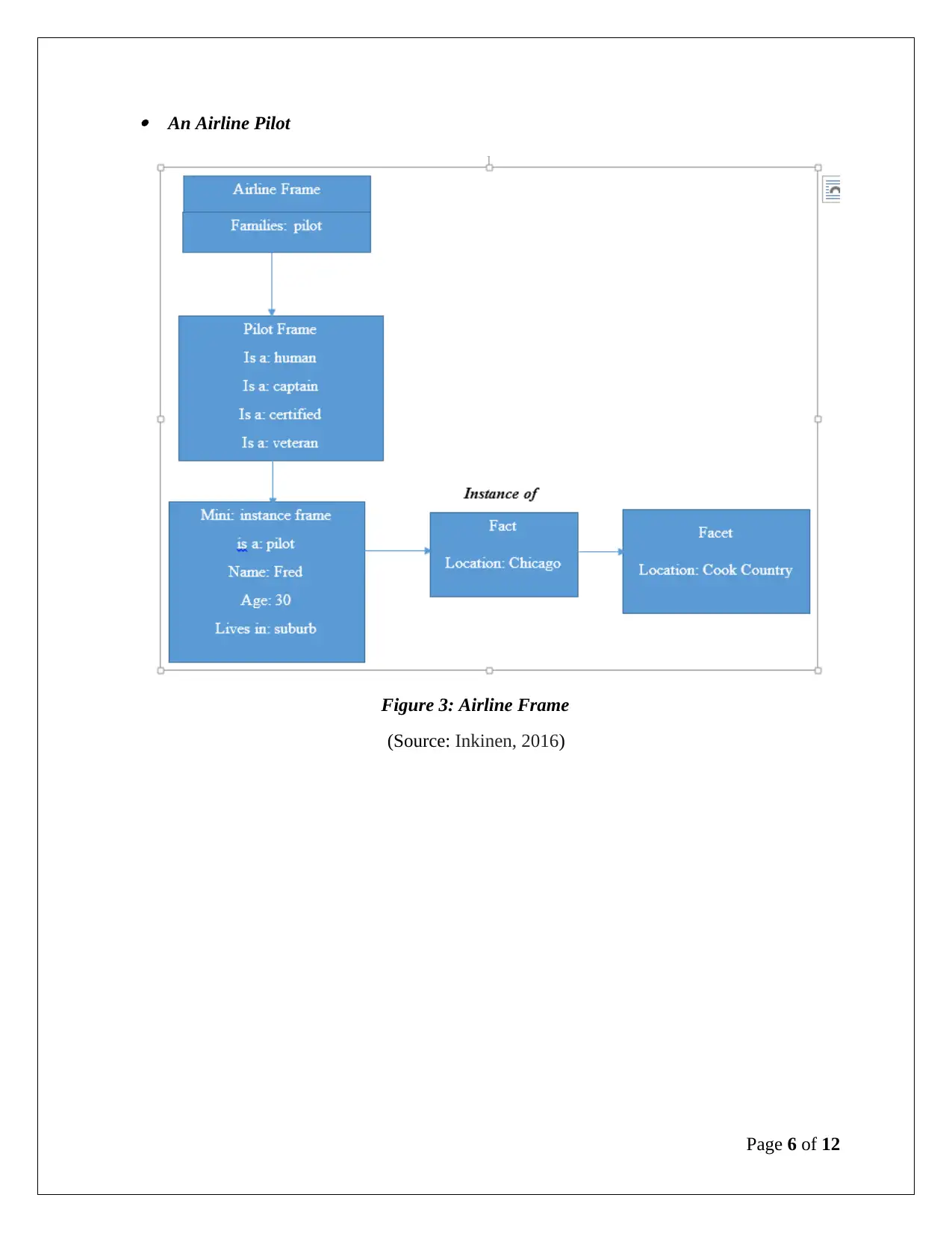
An Airline Pilot
Figure 3: Airline Frame
(Source: Inkinen, 2016)
Page 6 of 12
Figure 3: Airline Frame
(Source: Inkinen, 2016)
Page 6 of 12
Paraphrase This Document
Need a fresh take? Get an instant paraphrase of this document with our AI Paraphraser
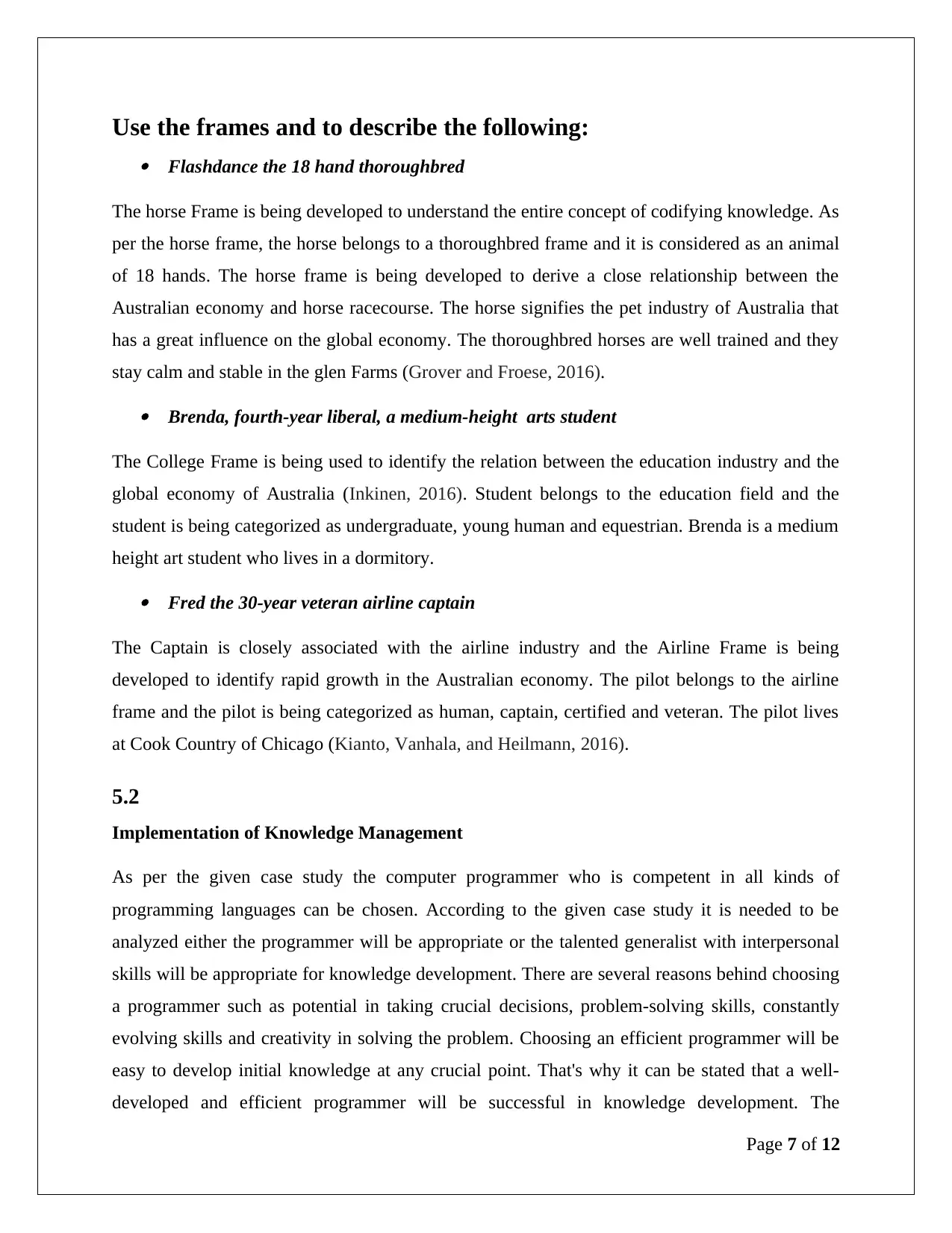
Use the frames and to describe the following: Flashdance the 18 hand thoroughbred
The horse Frame is being developed to understand the entire concept of codifying knowledge. As
per the horse frame, the horse belongs to a thoroughbred frame and it is considered as an animal
of 18 hands. The horse frame is being developed to derive a close relationship between the
Australian economy and horse racecourse. The horse signifies the pet industry of Australia that
has a great influence on the global economy. The thoroughbred horses are well trained and they
stay calm and stable in the glen Farms (Grover and Froese, 2016). Brenda, fourth-year liberal, a medium-height arts student
The College Frame is being used to identify the relation between the education industry and the
global economy of Australia (Inkinen, 2016). Student belongs to the education field and the
student is being categorized as undergraduate, young human and equestrian. Brenda is a medium
height art student who lives in a dormitory. Fred the 30-year veteran airline captain
The Captain is closely associated with the airline industry and the Airline Frame is being
developed to identify rapid growth in the Australian economy. The pilot belongs to the airline
frame and the pilot is being categorized as human, captain, certified and veteran. The pilot lives
at Cook Country of Chicago (Kianto, Vanhala, and Heilmann, 2016).
5.2
Implementation of Knowledge Management
As per the given case study the computer programmer who is competent in all kinds of
programming languages can be chosen. According to the given case study it is needed to be
analyzed either the programmer will be appropriate or the talented generalist with interpersonal
skills will be appropriate for knowledge development. There are several reasons behind choosing
a programmer such as potential in taking crucial decisions, problem-solving skills, constantly
evolving skills and creativity in solving the problem. Choosing an efficient programmer will be
easy to develop initial knowledge at any crucial point. That's why it can be stated that a well-
developed and efficient programmer will be successful in knowledge development. The
Page 7 of 12
The horse Frame is being developed to understand the entire concept of codifying knowledge. As
per the horse frame, the horse belongs to a thoroughbred frame and it is considered as an animal
of 18 hands. The horse frame is being developed to derive a close relationship between the
Australian economy and horse racecourse. The horse signifies the pet industry of Australia that
has a great influence on the global economy. The thoroughbred horses are well trained and they
stay calm and stable in the glen Farms (Grover and Froese, 2016). Brenda, fourth-year liberal, a medium-height arts student
The College Frame is being used to identify the relation between the education industry and the
global economy of Australia (Inkinen, 2016). Student belongs to the education field and the
student is being categorized as undergraduate, young human and equestrian. Brenda is a medium
height art student who lives in a dormitory. Fred the 30-year veteran airline captain
The Captain is closely associated with the airline industry and the Airline Frame is being
developed to identify rapid growth in the Australian economy. The pilot belongs to the airline
frame and the pilot is being categorized as human, captain, certified and veteran. The pilot lives
at Cook Country of Chicago (Kianto, Vanhala, and Heilmann, 2016).
5.2
Implementation of Knowledge Management
As per the given case study the computer programmer who is competent in all kinds of
programming languages can be chosen. According to the given case study it is needed to be
analyzed either the programmer will be appropriate or the talented generalist with interpersonal
skills will be appropriate for knowledge development. There are several reasons behind choosing
a programmer such as potential in taking crucial decisions, problem-solving skills, constantly
evolving skills and creativity in solving the problem. Choosing an efficient programmer will be
easy to develop initial knowledge at any crucial point. That's why it can be stated that a well-
developed and efficient programmer will be successful in knowledge development. The
Page 7 of 12
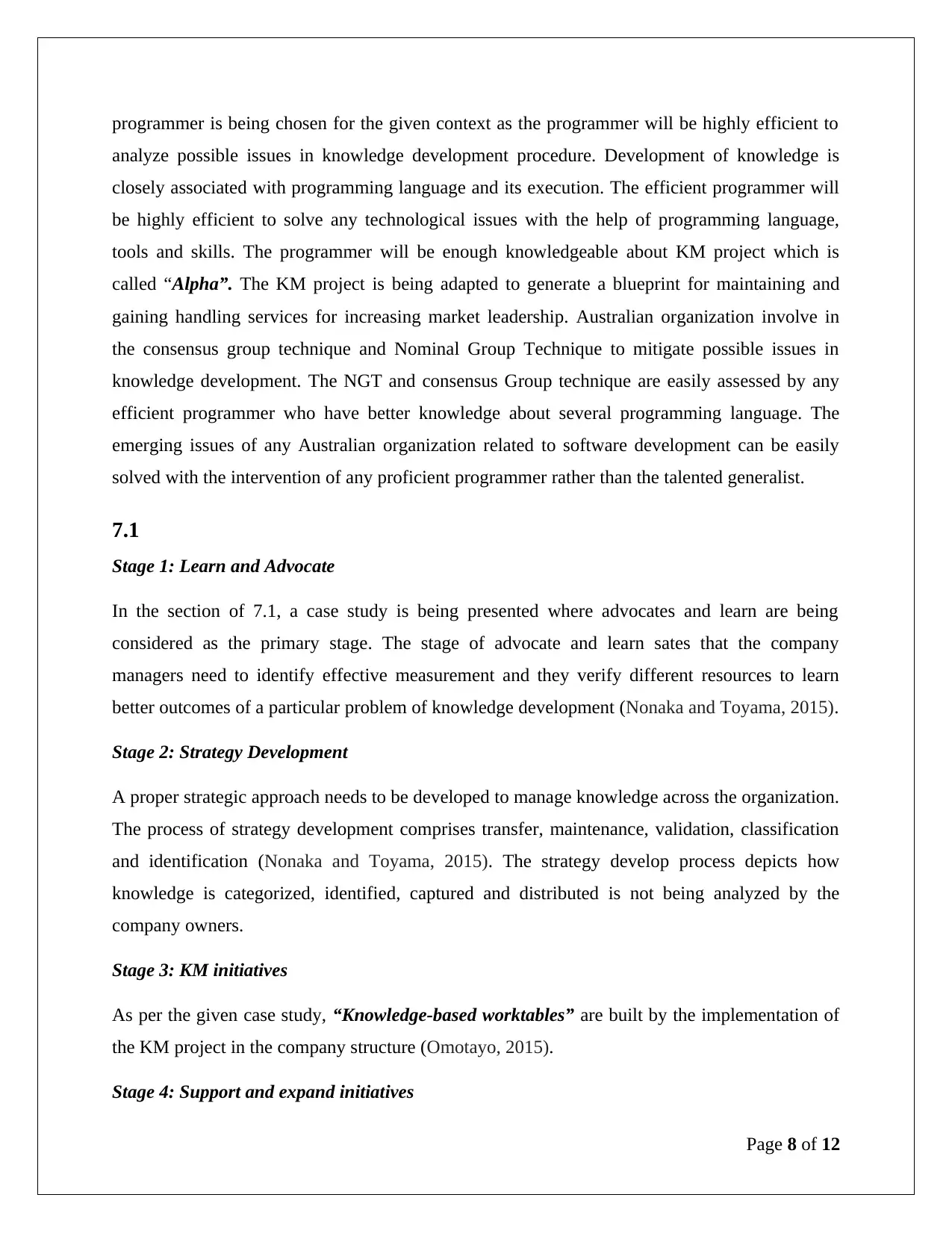
programmer is being chosen for the given context as the programmer will be highly efficient to
analyze possible issues in knowledge development procedure. Development of knowledge is
closely associated with programming language and its execution. The efficient programmer will
be highly efficient to solve any technological issues with the help of programming language,
tools and skills. The programmer will be enough knowledgeable about KM project which is
called “Alpha”. The KM project is being adapted to generate a blueprint for maintaining and
gaining handling services for increasing market leadership. Australian organization involve in
the consensus group technique and Nominal Group Technique to mitigate possible issues in
knowledge development. The NGT and consensus Group technique are easily assessed by any
efficient programmer who have better knowledge about several programming language. The
emerging issues of any Australian organization related to software development can be easily
solved with the intervention of any proficient programmer rather than the talented generalist.
7.1
Stage 1: Learn and Advocate
In the section of 7.1, a case study is being presented where advocates and learn are being
considered as the primary stage. The stage of advocate and learn sates that the company
managers need to identify effective measurement and they verify different resources to learn
better outcomes of a particular problem of knowledge development (Nonaka and Toyama, 2015).
Stage 2: Strategy Development
A proper strategic approach needs to be developed to manage knowledge across the organization.
The process of strategy development comprises transfer, maintenance, validation, classification
and identification (Nonaka and Toyama, 2015). The strategy develop process depicts how
knowledge is categorized, identified, captured and distributed is not being analyzed by the
company owners.
Stage 3: KM initiatives
As per the given case study, “Knowledge-based worktables” are built by the implementation of
the KM project in the company structure (Omotayo, 2015).
Stage 4: Support and expand initiatives
Page 8 of 12
analyze possible issues in knowledge development procedure. Development of knowledge is
closely associated with programming language and its execution. The efficient programmer will
be highly efficient to solve any technological issues with the help of programming language,
tools and skills. The programmer will be enough knowledgeable about KM project which is
called “Alpha”. The KM project is being adapted to generate a blueprint for maintaining and
gaining handling services for increasing market leadership. Australian organization involve in
the consensus group technique and Nominal Group Technique to mitigate possible issues in
knowledge development. The NGT and consensus Group technique are easily assessed by any
efficient programmer who have better knowledge about several programming language. The
emerging issues of any Australian organization related to software development can be easily
solved with the intervention of any proficient programmer rather than the talented generalist.
7.1
Stage 1: Learn and Advocate
In the section of 7.1, a case study is being presented where advocates and learn are being
considered as the primary stage. The stage of advocate and learn sates that the company
managers need to identify effective measurement and they verify different resources to learn
better outcomes of a particular problem of knowledge development (Nonaka and Toyama, 2015).
Stage 2: Strategy Development
A proper strategic approach needs to be developed to manage knowledge across the organization.
The process of strategy development comprises transfer, maintenance, validation, classification
and identification (Nonaka and Toyama, 2015). The strategy develop process depicts how
knowledge is categorized, identified, captured and distributed is not being analyzed by the
company owners.
Stage 3: KM initiatives
As per the given case study, “Knowledge-based worktables” are built by the implementation of
the KM project in the company structure (Omotayo, 2015).
Stage 4: Support and expand initiatives
Page 8 of 12
⊘ This is a preview!⊘
Do you want full access?
Subscribe today to unlock all pages.

Trusted by 1+ million students worldwide
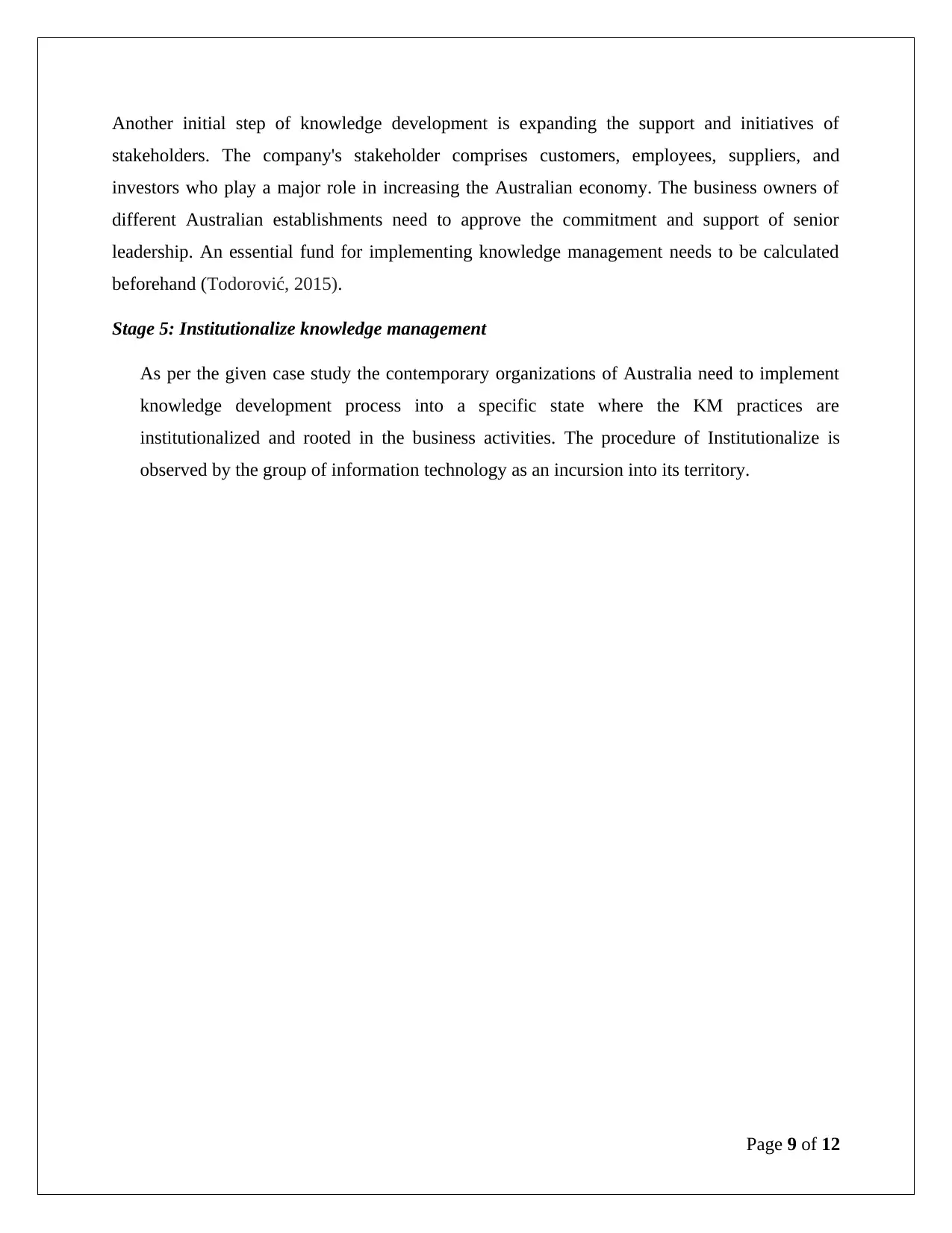
Another initial step of knowledge development is expanding the support and initiatives of
stakeholders. The company's stakeholder comprises customers, employees, suppliers, and
investors who play a major role in increasing the Australian economy. The business owners of
different Australian establishments need to approve the commitment and support of senior
leadership. An essential fund for implementing knowledge management needs to be calculated
beforehand (Todorović, 2015).
Stage 5: Institutionalize knowledge management
As per the given case study the contemporary organizations of Australia need to implement
knowledge development process into a specific state where the KM practices are
institutionalized and rooted in the business activities. The procedure of Institutionalize is
observed by the group of information technology as an incursion into its territory.
Page 9 of 12
stakeholders. The company's stakeholder comprises customers, employees, suppliers, and
investors who play a major role in increasing the Australian economy. The business owners of
different Australian establishments need to approve the commitment and support of senior
leadership. An essential fund for implementing knowledge management needs to be calculated
beforehand (Todorović, 2015).
Stage 5: Institutionalize knowledge management
As per the given case study the contemporary organizations of Australia need to implement
knowledge development process into a specific state where the KM practices are
institutionalized and rooted in the business activities. The procedure of Institutionalize is
observed by the group of information technology as an incursion into its territory.
Page 9 of 12
Paraphrase This Document
Need a fresh take? Get an instant paraphrase of this document with our AI Paraphraser
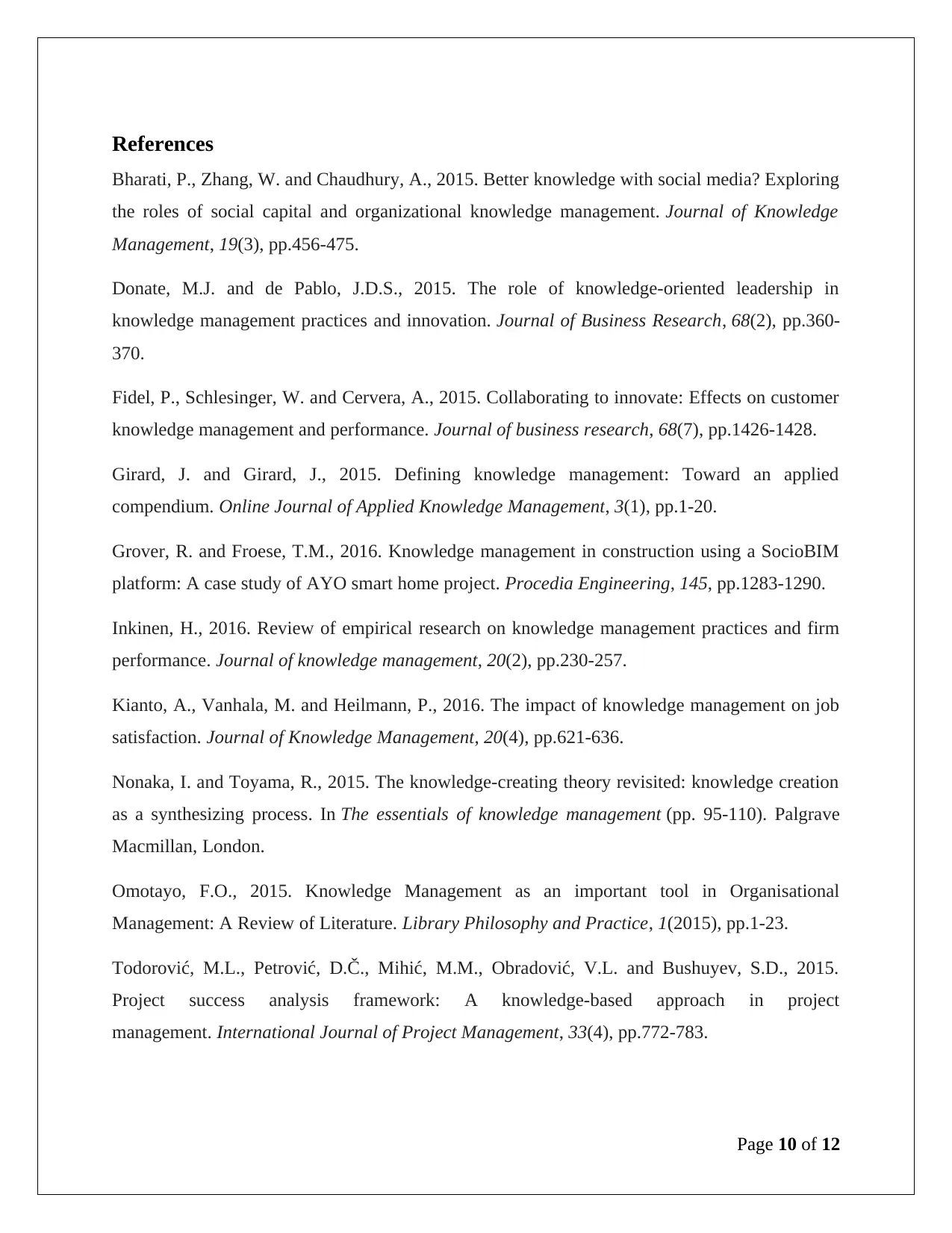
References
Bharati, P., Zhang, W. and Chaudhury, A., 2015. Better knowledge with social media? Exploring
the roles of social capital and organizational knowledge management. Journal of Knowledge
Management, 19(3), pp.456-475.
Donate, M.J. and de Pablo, J.D.S., 2015. The role of knowledge-oriented leadership in
knowledge management practices and innovation. Journal of Business Research, 68(2), pp.360-
370.
Fidel, P., Schlesinger, W. and Cervera, A., 2015. Collaborating to innovate: Effects on customer
knowledge management and performance. Journal of business research, 68(7), pp.1426-1428.
Girard, J. and Girard, J., 2015. Defining knowledge management: Toward an applied
compendium. Online Journal of Applied Knowledge Management, 3(1), pp.1-20.
Grover, R. and Froese, T.M., 2016. Knowledge management in construction using a SocioBIM
platform: A case study of AYO smart home project. Procedia Engineering, 145, pp.1283-1290.
Inkinen, H., 2016. Review of empirical research on knowledge management practices and firm
performance. Journal of knowledge management, 20(2), pp.230-257.
Kianto, A., Vanhala, M. and Heilmann, P., 2016. The impact of knowledge management on job
satisfaction. Journal of Knowledge Management, 20(4), pp.621-636.
Nonaka, I. and Toyama, R., 2015. The knowledge-creating theory revisited: knowledge creation
as a synthesizing process. In The essentials of knowledge management (pp. 95-110). Palgrave
Macmillan, London.
Omotayo, F.O., 2015. Knowledge Management as an important tool in Organisational
Management: A Review of Literature. Library Philosophy and Practice, 1(2015), pp.1-23.
Todorović, M.L., Petrović, D.Č., Mihić, M.M., Obradović, V.L. and Bushuyev, S.D., 2015.
Project success analysis framework: A knowledge-based approach in project
management. International Journal of Project Management, 33(4), pp.772-783.
Page 10 of 12
Bharati, P., Zhang, W. and Chaudhury, A., 2015. Better knowledge with social media? Exploring
the roles of social capital and organizational knowledge management. Journal of Knowledge
Management, 19(3), pp.456-475.
Donate, M.J. and de Pablo, J.D.S., 2015. The role of knowledge-oriented leadership in
knowledge management practices and innovation. Journal of Business Research, 68(2), pp.360-
370.
Fidel, P., Schlesinger, W. and Cervera, A., 2015. Collaborating to innovate: Effects on customer
knowledge management and performance. Journal of business research, 68(7), pp.1426-1428.
Girard, J. and Girard, J., 2015. Defining knowledge management: Toward an applied
compendium. Online Journal of Applied Knowledge Management, 3(1), pp.1-20.
Grover, R. and Froese, T.M., 2016. Knowledge management in construction using a SocioBIM
platform: A case study of AYO smart home project. Procedia Engineering, 145, pp.1283-1290.
Inkinen, H., 2016. Review of empirical research on knowledge management practices and firm
performance. Journal of knowledge management, 20(2), pp.230-257.
Kianto, A., Vanhala, M. and Heilmann, P., 2016. The impact of knowledge management on job
satisfaction. Journal of Knowledge Management, 20(4), pp.621-636.
Nonaka, I. and Toyama, R., 2015. The knowledge-creating theory revisited: knowledge creation
as a synthesizing process. In The essentials of knowledge management (pp. 95-110). Palgrave
Macmillan, London.
Omotayo, F.O., 2015. Knowledge Management as an important tool in Organisational
Management: A Review of Literature. Library Philosophy and Practice, 1(2015), pp.1-23.
Todorović, M.L., Petrović, D.Č., Mihić, M.M., Obradović, V.L. and Bushuyev, S.D., 2015.
Project success analysis framework: A knowledge-based approach in project
management. International Journal of Project Management, 33(4), pp.772-783.
Page 10 of 12

Page 11 of 12
⊘ This is a preview!⊘
Do you want full access?
Subscribe today to unlock all pages.

Trusted by 1+ million students worldwide
1 out of 12
Related Documents
Your All-in-One AI-Powered Toolkit for Academic Success.
+13062052269
info@desklib.com
Available 24*7 on WhatsApp / Email
![[object Object]](/_next/static/media/star-bottom.7253800d.svg)
Unlock your academic potential
Copyright © 2020–2025 A2Z Services. All Rights Reserved. Developed and managed by ZUCOL.



